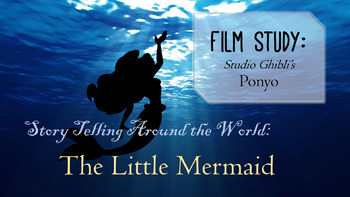Film Study / Ponyo - Storytelling Around the World: The Little Mermaid
Teaching Middle School in Verse
7 Followers
Grade Levels
2nd - 12th
Subjects
Resource Type
Standards
CCSSRL.2.9
CCSSRL.3.2
CCSSRL.4.7
CCSSRL.4.9
CCSSRL.5.7
Formats Included
- Zip
Pages
26 pages
Teaching Middle School in Verse
7 Followers
Description
Topics: Film Study, Venn Diagram, Compare & Contrast, Culture, Discussion
This film study includes materials for the film Ponyo, a Japanese animated film based on Hans Christian Anderson’s The Little Mermaid. Perfect for extra instructional days or for a more complex unit on how own cultural lens impacts storytelling!
Lesson Components:
1) Interactive PowerPoint introduces the film and its source material, The Little Mermaid
2) Show students how to use a three-way Venn diagram to develop their comparing & contrasting skills
3) Modify the film-viewing experience with supplementary activities
4) Use the Discussion Guide to debrief
You’ll receive the following materials:
• PowerPoint presentation (.pptx file) & script
• Lesson plans with suggestions for pre- and post-viewing activities
• Venn diagram printables (two- and three-way)
• Elementary-level Story Map printable
• Middle/High Film Study & Cornell Method Notetaking printable
A Note on Grade-level:
This product was originally designed for middle school classrooms; however, the film Ponyo is fully accessible to younger students and can be matched to common core standards as early as second grade (see preview for full list of applicable standards)! To help with modification, I’ve included materials and discussion questions for all grade levels.
This film study includes materials for the film Ponyo, a Japanese animated film based on Hans Christian Anderson’s The Little Mermaid. Perfect for extra instructional days or for a more complex unit on how own cultural lens impacts storytelling!
Lesson Components:
1) Interactive PowerPoint introduces the film and its source material, The Little Mermaid
2) Show students how to use a three-way Venn diagram to develop their comparing & contrasting skills
3) Modify the film-viewing experience with supplementary activities
4) Use the Discussion Guide to debrief
You’ll receive the following materials:
• PowerPoint presentation (.pptx file) & script
• Lesson plans with suggestions for pre- and post-viewing activities
• Venn diagram printables (two- and three-way)
• Elementary-level Story Map printable
• Middle/High Film Study & Cornell Method Notetaking printable
A Note on Grade-level:
This product was originally designed for middle school classrooms; however, the film Ponyo is fully accessible to younger students and can be matched to common core standards as early as second grade (see preview for full list of applicable standards)! To help with modification, I’ve included materials and discussion questions for all grade levels.
Total Pages
26 pages
Answer Key
N/A
Teaching Duration
4 days
Report this resource to TPT
Reported resources will be reviewed by our team. Report this resource to let us know if this resource violates TPT’s content guidelines.
Standards
to see state-specific standards (only available in the US).
CCSSRL.2.9
Compare and contrast two or more versions of the same story (e.g., Cinderella stories) by different authors or from different cultures.
CCSSRL.3.2
Recount stories, including fables, folktales, and myths from diverse cultures; determine the central message, lesson, or moral and explain how it is conveyed through key details in the text.
CCSSRL.4.7
Make connections between the text of a story or drama and a visual or oral presentation of the text, identifying where each version reflects specific descriptions and directions in the text.
CCSSRL.4.9
Compare and contrast the treatment of similar themes and topics (e.g., opposition of good and evil) and patterns of events (e.g., the quest) in stories, myths, and traditional literature from different cultures.
CCSSRL.5.7
Analyze how visual and multimedia elements contribute to the meaning, tone, or beauty of a text (e.g., graphic novel, multimedia presentation of fiction, folktale, myth, poem).





